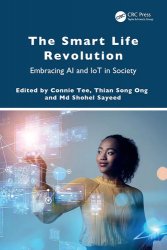The Smart Life Revolution: Embracing AI and IoT in Society
- Добавил: literator
- Дата: 10-06-2025, 08:13
- Комментариев: 0
 Название: The Smart Life Revolution: Embracing AI and IoT in Society
Название: The Smart Life Revolution: Embracing AI and IoT in SocietyАвтор: Connie Tee, Thian Song Ong, Md Shohel Sayeed
Издательство: CRC Press
Год: 2025
Страниц: 293
Язык: английский
Формат: pdf (true), epub
Размер: 25.8 MB
This book explores the integration of Artificial Intelligence (AI) across areas such as IoT, Big Data, healthcare, business, economics, and security, and improving the quality of life (QoL) in smart cities today.
By looking in depth at the different application areas of AI, the reader learns about the broad and impactful ways AI is transforming our world, its profound influence in enhancing service efficiency, personalization, accessibility, and fostering both scientific and social advancement. The editors consider the importance of bridging theory and practice by offering a practical understanding of how key AI technologies can be applied in real-world scenarios for QoL. By covering both foundational concepts and advanced applications with case studies and practical examples, this approach ensures the reader obtains a comprehensive understanding of the technologies and their impact. An innovation mindset is emphasized with discussion about the challenges, opportunities, future trends, and potential research directions to prepare readers for ongoing technological advancements. The book takes an interdisciplinary approach by integrating knowledge from Computer Science, engineering, and social sciences, to offer a holistic view of technology's role in society.
Biometric authentication has gained popularity in recent years as the demand for reliable and simple identification methods has increased across a wide range of applications. Biometric technologies have become an essential part of modern security solutions due to their improved security, resilience and ease of use achieved through rapid technological development compared to traditional methods using passwords or PINs. Although biometrics bring the benefits mentioned above, they also come with some challenges, such as privacy concerns, cyber-attack issues and system performance issues. Therefore, a comprehensive understanding of biometric features, their use in user identification and the variables that influence the effectiveness of the system is important to address the above issues and ensure the continued effectiveness and reliability of biometric systems.
Face recognition technology exists as a type of biometric security that uses biometric data and characteristics of the face to confirm a person’s identity. This technology can be used to identify people in photos, videos and ultimately in real-time. Face recognition has attracted the interest of researchers because it enables non-intrusive recognition and provides proof of a person’s identity without their consent or cooperation. Face recognition is divided into three types: 2D, 2.5D and 3D. 2D face recognition is a facial recognition strategy that utilises the two-dimensional structure of the human face. It is more accepted by the public and requires a less expensive image-capture device. 3D face recognition requires a 3D scanner to capture a person’s facial characteristics across the entire head. The geometric details in the 3D feature improve the recognition rate in difficult situations. 2.5D face recognition appears like a 2D format but consists of a 3D facial structure.
This book serves as a valuable resource for both undergraduate and postgraduate students in the study of AI applications in society. The book may be used for researchers and communities to identify the different challenges associated with key technologies for building new applications for improving quality of lives in smart cities.
Скачать The Smart Life Revolution: Embracing AI and IoT in Society
[related-news] [/related-news]
Внимание
Уважаемый посетитель, Вы зашли на сайт как незарегистрированный пользователь.
Мы рекомендуем Вам зарегистрироваться либо войти на сайт под своим именем.
Уважаемый посетитель, Вы зашли на сайт как незарегистрированный пользователь.
Мы рекомендуем Вам зарегистрироваться либо войти на сайт под своим именем.
